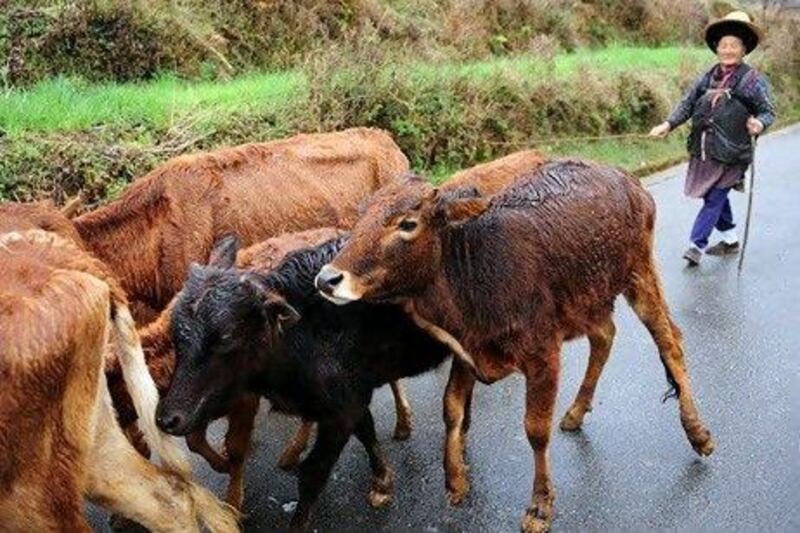When it comes to consumerism, China is the place on everyone's mind.
Luxury goods, cars, iPhones - it seems the world's most populous nation is driving increases in demand for all of them.
There is another sector, one linked to the nation's dinner tables, that is less talked about but arguably of greater significance than many of the others.
Meat consumption in China is growing at a breathless pace and the reverberations are being felt globally.
After all, when 1.3 billion people are changing their diets, the effect on world markets for everything from soya beans to breeding animals is significant.
Turn the clock back to 1995 and Chinese people were on average eating a modest 25kg of meat per year. Now the figure is more than 53kg.
Urban meat consumption in China is close to double that, on a per capita basis, of the countryside. So with more than 10 million extra urban dwellers per year, demand will continue to grow.
In line with this, China is the world's largest meat producer, generating about 76.5 million tonnes a year, or 29 per cent of the world's total.
This total is increasing fast and according to China's 12th five-year plan, by 2015 domestic meat production will be 86 million tonnes a year. Achieving this growth will require a transition to larger, high-tech facilities and improvements in the quality of livestock.
"Having a large number of small farms within the industry, it's a very volatile industry," says Michael Boddington, the managing director of Asian Agribusiness Consulting, based in Beijing.
"When you have disease, the farms don't have the capability to prevent disease, to know how to handle disease."
Foreign consultants are flooding in to offer expertise in developing global-standard facilities and multinationals are investing in the country's agricultural sector.
Vast sums are also being spent on procuring better livestock from overseas. Last year, China spent US$41 million (Dh150.6m) on foreign live breeding animals and foreign animal genetics, Reuters reported, three times the figure of just five years ago.
Thanks to intensive improvement programmes, chickens from the United States can grow to maturity in as little as one third the time of some local birds. Top-quality imported breeding livestock are also likely to be more resistant to illness and to produce greater numbers of offspring, sometimes almost twice as many per year.
Gradually the foreign animal varieties will replace the lower-yielding indigenous animals and that means, in the long term, it is likely that the country's reliance on breeding animals from abroad will decrease as the quality of China's own livestock increases.
As observers have noted, what China is doing with animal farming - taking best practice and technology from overseas and making these its own with the aim of reducing the dependence on foreign expertise - has many parallels with the way other sectors of Chinese industry have developed.
Yet with the total number of farm animals increasing in China, eliminating the country's reliance on imported soya beans and corn may prove more difficult.
Some analysts have talked of "a new strategic dependency", especially as pressure on agricultural land limits China's ability to increase outputs of these key crops.
China's soya bean imports could grow to 68 million tonnes by 2014, according to projections, which is close to one third higher than last year's figure. Already soya bean imports constitute about half of global soya bean exports.
With corn, China was a net importer for more than a decade until 2010 but it is now a net importer and likely to remain so. Only last month, there was news that US corn futures were reaching near double-digit increases, partly on the back of growing Chinese demand.
While demand for meat and animal feed is set to increase, not every type of meat will experience the same level of growth.
Food price inflation is a major concern, so chicken - half as expensive as some other forms of meat - is predicted to become more popular. Beef and mutton are also likely to take greater market share as the quantities of the various types of meat consumed in China achieve a balance closer to more developed markets.
For all that China's meat industry seems intent on reaching global standards, experts predict turbulence ahead. This is partly because even the planned rapid increases in meat production are not likely to consistently satisfy demand.
Thanks to the size of the Chinese population, even small shortfalls in domestic meat production in percentage terms can lead to significant growth in imports.
That could have major consequences around the world.
"Just a small change [in demand] here has big global implications because of the maths," says Mr Boddington.
But at the moment at least, for China it seems to add up.
[ dbardsley@the national.ae ]
twitter: Follow and share our breaking business news. Follow us
iPad users can follow our twitterfeed via Flipboard - just search for Ind_Insights on the app.






